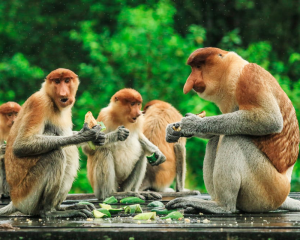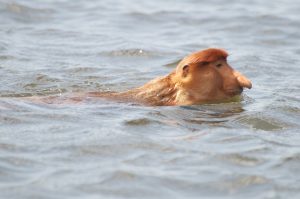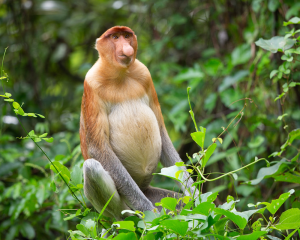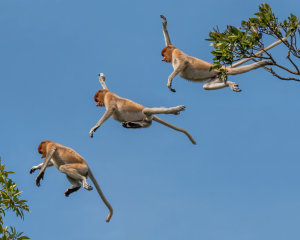
The proboscis monkey (Nasalis larvatus) is a distinctive and unusual primate known for its large nose, reddish-brown fur, and unique adaptations to its habitat. Native to the island of Borneo in Southeast Asia, this species is the only member of the genus Nasalis. Proboscis monkeys are fascinating due to their appearance, behavior, and ecological role in their environments.
General Characteristics
Physical Appearance
The most notable feature of the proboscis monkey is the large, protruding nose, especially prominent in males. This large nose can grow up to 10 centimeters (4 inches) and hangs down over the mouth. Females and juveniles have much smaller noses.
Proboscis monkeys have a reddish-brown to orange coat on their back, shoulders, and head, with a lighter, greyish belly. Their limbs and tails are typically grey.
Males are significantly larger than females, exhibiting strong sexual dimorphism. Adult males can weigh between 16 to 24 kilograms (35 to 53 pounds) and measure up to 76 centimeters (30 inches) in body length, with a tail that is nearly as long. Females are smaller, weighing about 7 to 12 kilograms (15 to 26 pounds) and measuring up to 60 centimeters (24 inches) in body length.
Their long tails, which are not prehensile, are used for balance when navigating through trees.

Behavior
Proboscis monkeys are primarily arboreal, meaning they spend most of their time in the trees. They are known for their strong swimming abilities, often swimming across rivers and mangrove channels to move between habitats or escape predators. They have partially webbed feet, which help them swim efficiently.
They are diurnal, being most active during the day. They spend much of their day feeding, resting, and grooming, often along rivers or in the forest canopy.
Proboscis monkeys live in groups called bands, typically consisting of a single adult male, multiple females, and their offspring. Bachelor groups, made up of young males who have left their natal groups, are also common.
Their social structure is flexible, and bands often come together to form larger troops, particularly when resting or foraging.

Habitat
Proboscis monkeys are endemic to Borneo, where they inhabit coastal and riverine forests, mangroves, and swamps. They are especially adapted to lowland rainforests and mangrove forests close to rivers, streams, and other water sources.
They are typically found at elevations up to 200 meters (656 feet) and prefer environments that provide a mix of food sources and proximity to water.
Diet
Proboscis monkeys are primarily folivorous, meaning they primarily eat leaves. However, they have a varied diet that also includes fruits, seeds, flowers, and occasionally insects. They are known to consume over 90 different plant species.
Their diet changes seasonally; during fruiting seasons, they eat more fruit, while in other seasons, they rely more heavily on leaves and other vegetation.
Proboscis monkeys have a specialized digestive system, with a multi-chambered stomach similar to that of cows. This allows them to ferment and break down tough plant material, particularly cellulose-rich leaves.

Social Structure and Behavior
Social Organization
Proboscis monkeys have a multi-level social structure. The basic unit is a one-male group (harem) consisting of one adult male, several females, and their offspring. These groups can join with other harems to form larger troops, especially at sleeping sites near rivers.
Bachelor groups are also common and consist of several young males who have left their natal groups. These males will eventually challenge dominant males in harems to take over and establish their own groups.
Group dynamics are fluid, with frequent changes in group composition, particularly in harems where males may be replaced after challenges from bachelor males.
Reproduction
Proboscis monkeys do not have a specific breeding season; mating and births can occur throughout the year. However, there may be peaks in births during times of food abundance.
The gestation period is around 166 days (about 5.5 months), and females usually give birth to a single offspring. Infants are born with a bluish face, which gradually turns to the adult coloration as they mature.
Females reach sexual maturity at around 5 years of age, while males mature later, around 6 to 7 years of age.




